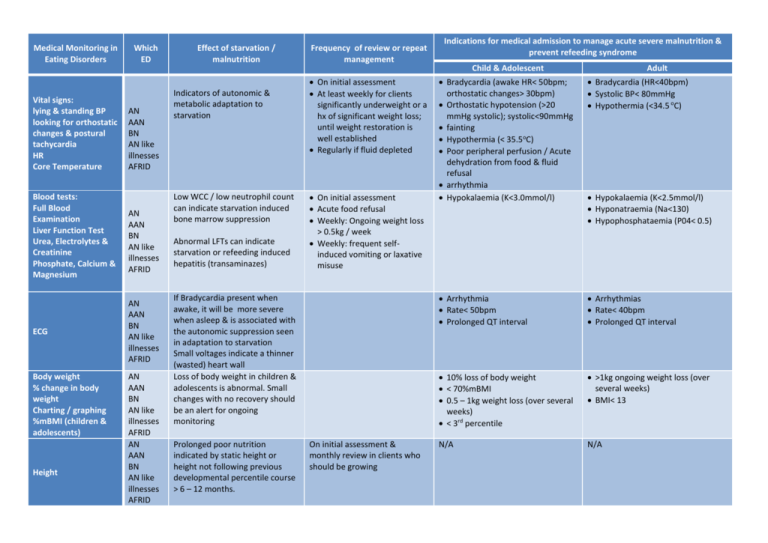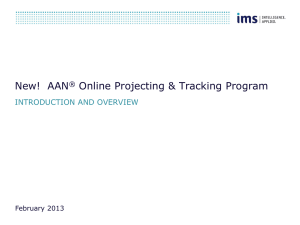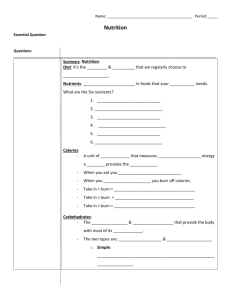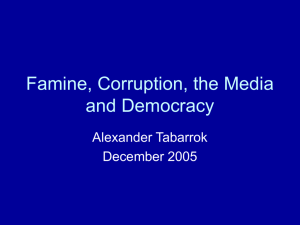Medical Monitoring in Eating Disorders Which ED Effect of starvation
advertisement

Medical Monitoring in Eating Disorders Vital signs: lying & standing BP looking for orthostatic changes & postural tachycardia HR Core Temperature Blood tests: Full Blood Examination Liver Function Test Urea, Electrolytes & Creatinine Phosphate, Calcium & Magnesium ECG Body weight % change in body weight Charting / graphing %mBMI (children & adolescents) Height Which ED AN AAN BN AN like illnesses AFRID AN AAN BN AN like illnesses AFRID AN AAN BN AN like illnesses AFRID AN AAN BN AN like illnesses AFRID AN AAN BN AN like illnesses AFRID Effect of starvation / malnutrition Indicators of autonomic & metabolic adaptation to starvation Low WCC / low neutrophil count can indicate starvation induced bone marrow suppression Abnormal LFTs can indicate starvation or refeeding induced hepatitis (transaminazes) Frequency of review or repeat management On initial assessment At least weekly for clients significantly underweight or a hx of significant weight loss; until weight restoration is well established Regularly if fluid depleted On initial assessment Acute food refusal Weekly: Ongoing weight loss > 0.5kg / week Weekly: frequent selfinduced vomiting or laxative misuse If Bradycardia present when awake, it will be more severe when asleep & is associated with the autonomic suppression seen in adaptation to starvation Small voltages indicate a thinner (wasted) heart wall Loss of body weight in children & adolescents is abnormal. Small changes with no recovery should be an alert for ongoing monitoring Prolonged poor nutrition indicated by static height or height not following previous developmental percentile course > 6 – 12 months. On initial assessment & monthly review in clients who should be growing Indications for medical admission to manage acute severe malnutrition & prevent refeeding syndrome Child & Adolescent Adult Bradycardia (awake HR< 50bpm; orthostatic changes> 30bpm) Orthostatic hypotension (>20 mmHg systolic); systolic<90mmHg fainting Hypothermia (< 35.5oC) Poor peripheral perfusion / Acute dehydration from food & fluid refusal arrhythmia Hypokalaemia (K<3.0mmol/l) Bradycardia (HR<40bpm) Systolic BP< 80mmHg Hypothermia (<34.5 oC) Arrhythmia Rate< 50bpm Prolonged QT interval Arrhythmias Rate< 40bpm Prolonged QT interval 10% loss of body weight < 70%mBMI 0.5 – 1kg weight loss (over several weeks) < 3rd percentile >1kg ongoing weight loss (over several weeks) BMI< 13 N/A N/A Hypokalaemia (K<2.5mmol/l) Hyponatraemia (Na<130) Hypophosphataemia (P04< 0.5) Medical Monitoring in Eating Disorders Micronutrients: Vitamin B12 Folate Iron Studies Vit D Menstrual function: frequency & quality of menses ovarian ultra sound Which ED All eating disorders All eating disorders Other behaviours: Eating & Drinking: Severe food restriction or acute food refusal Severe fluid restriction or acute fluid refusal Increased frequency of purging behaviours Effect of starvation / malnutrition May be impaired due to general malnutrition or restricted food variety Starvation induced suppression of oestrogen pituitary axis Restriction of food (& fluids) is a core behaviour in many EDs All eating disorders Physical activity aimed at weight control may be a primary weight control behaviour, or a behaviour to compensate for binge eating Frequency of review or repeat management On initial assessment & reviewed as clinically indicated Supplement as indicated Encourage improved food variety & quantity Review menstrual function on initial assessment & routinely to note changes Ovarian ultra sound may be helpful in determining minimal healthy weight when clinical picture & hx are inadequate Indications for medical admission to manage acute severe malnutrition & prevent refeeding syndrome Child & Adolescent N/A Acute food & / or fluid refusal > 3days Acute worsening in these symptoms requires increased frequency of medical monitoring; medical admission may be indicated Starved individuals may have difficulties with restlessness Physical Activity: Exercise, incidental activity & weight controlling physical activity Bone / Bone density assessment AN AAN BN AN like illnesses AFRID Starvation induced osteopenia & osteoporosis Related to suppression of ovulation & cortisol changes Weight & nutrition status recovery is the best treatment. Calcium supplementation may be of some use. Not improved by OC. In long term underweight , consider bisposhonates for non-child bearing age & gender groups Adult N/A Acute food & / or fluid refusal > 3 – 5 days








